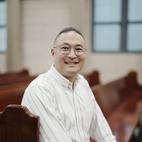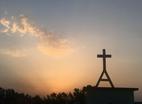Starting from scratch, a Guangxi church has more than one thousand churchgoers of Zhuang, Miao and Han nationalities.
Built in 1875 by a British pastor in Yongtai Street, Shangsi County Gospel Church had five pastors and other clergy in 1939. After that, all activities were stopped due to bombing by Japanese planes.
By the end of 1996 after the reform and opening up, Pastor Ling Daiming, who had been living in Taipei County, Taiwan Province, nearly 70 years old, returned alone to Shangsi County, his hometown. He found that there were no Christians among the villagers who still adhered to folk beliefs. He felt obliged to preach the gospel to his folks. So the Bible sharing gathering was started 60 years after the church was closed at the home of his sister, Ling Ruqing, who lived in the Bell and Drum Tower. This gathering made up for the blank world of faith in the county.
Without churches but only a private house, Rev. Ling overcame all kinds of difficulties to invite Rev. Paul Liang, chairman of the Guangxi TSPM, to give sermons. In January 1997, 28 believers including Huang Xiang, who is now the head of the church, were baptized, becoming the first batch of Christians in the county after the reform and opening up. Thirty were baptized in the second batch, 35 in the third, and 50 in the fifth... At present, there are more than one thousand believers of Zhuang, Miao and Han nationalities.
In order to have a legal gathering organization, the first batch of believers applied for restoration of the church, which was approved.
After that, they began to plan on how to build a church, as the family gathering site could not accommodate the increasing number of faithful. After many setbacks, they received government permission to build the church. Despite the absence of design and construction teams, and funds for the construction, God opened the way. The first Christian church in Shangsi County was built, starting from March 2004 until July 2005.
In the early days of gathering after the church was built, pastors from Guangxi CC&TSPM (Christian Council & Three-self Patriotic Movement) were invited to preach and preside over the communion on the first Sunday of each month, as there were no full-time pastors except Rev. Ling. Having finished one-year training in the Guangxi CC&TSPM, Sister Zeng Bihui went to Hunan Bible School to study for three years. After returning to her hometown and serving in the church for three years, she was ordained as a pastor, becoming the first pastor in Shangsi County after the reform and opening up. At the same time, eleven staff workers from the church went to the Guangxi CC&TSPM to be trained as volunteer evangelists. Currently, the church has two full-time and five volunteer pastors.
The church is a three-story building combining Chinese and Western elements, with a usable area of 600 square meters (0.148 acres) and a floor area of 1,400 square meters (0.346 acres). The church sits northward, with a striking cross on the wall of the west gate on the second floor. Different from other churches with "Immanuel" as background, there is a big map of the world under the cross inside the sanctuary of the church. On the map, bold red letters are written to express the grace of God: "Believe in the Lord Jesus, and you will be saved, you and your household.” (Acts 16:31)
Located in Shangsi County, Fangchenggang City, the church is the first multi-ethnic church mainly composed of Zhuang, including Yao and Han nationalities. They contribute a certain amount of cash every month to the pastors in the surrounding meeting points.
In order to better shepherd the congregation, they hold two Sunday services, the first in local dialect and the second in Mandarin.
Another highlight of this church is the openness of its finances. They disclose the financial affairs once a week to the congregation in the form of a table, including how much is contributed by the believers, raised by the church, and how the money is used.
Decorated with lights and festoons on each Christmas, Easter, Spring Festival, and other traditional Chinese festivals, the church organizes its members to perform artistic programs to praise God through hymns, dances, sketches, and Nativity plays. In response to the government’s request of participating in public welfare activities, the church makes donations to the disabled, the sick, poor students and people in disaster.
(The original article is published by Gospel Time)
- Translated by Abigail Wu












